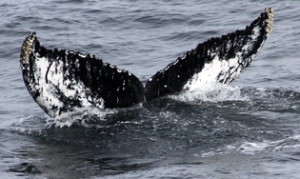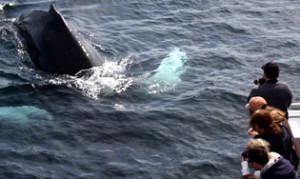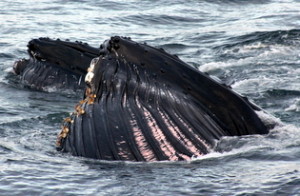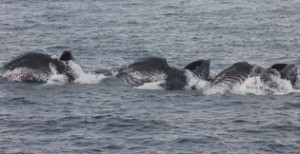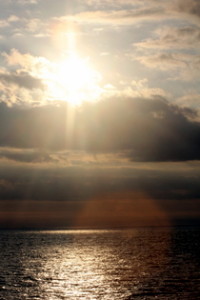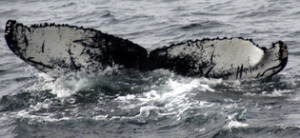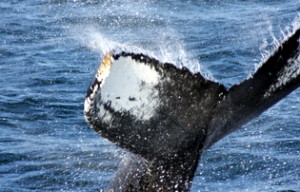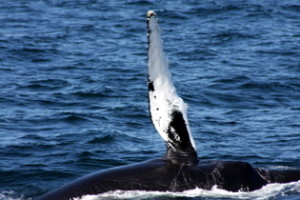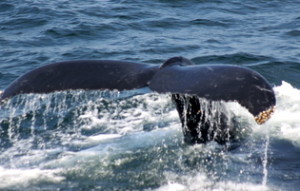September 24 to September 30
On September 24th our single trip offshore brought us way out towards the northeastern side of Stellwagen Bank where we got great, close looks at three different fin whales. Fin whales can be spotted in Cape Cod waters throughout the year, but it is unknown as to whether they are the same individuals year round or whether different individuals visit Stellwagen and the surrounding areas in different seasons. Despite observing these fin whales in every season, there is still a lot to learn about these enormous creatures.
Only one humpback, a female named Nazca, was spotted on this afternoon’s trip. In the photo below, look closely at the pattern on the underside of her tail. She was named for their resemblance to the Nazca line drawings found in Peru.
The heavy fog and rough seas on September 24th made for a difficult day out on the water. We traveled all the way out to the BD buoy, which is to the east of Stellwagen Bank and generally farther than we venture, but we were determined to find some whales for our patient passengers! We did manage to snag a look at a very tiny Minke whale off of Wood End. From the size of it, our naturalist estimated that it couldn’t have been more than 1 1/2 years old!
We also had an excellent look at two Mola molas, or ocean sunfish, and one of them was simply enormous. Although they are fish, mola molas are considered the largest type of plankton because their large-scale movements are largely determined by currents. Even so, they can weigh up to 600 pounds and have a diameter of several feet!
With clear skies and flat seas on September 26th we had significantly more luck than previous days, although we did have head rather far to the east again. At one point we noticed on the depth sounder than we were in over 600 feet of water! The calm water gave us a great opportunity to spot both humpback whales and fin whales on the morning trip. Both species are types of baleen whales, although they vary significantly in length and shape. At one point, two humpbacks and one fin whale surfaced right next to each other simultaneously and we were able to contrast the fin whale’s long sleek body with the stocky, football-shaped humpback. Today, one of the humpbacks making an appearance was the 2009 calf of a whale named Shark.
These difference in physical structures lead to behavioral changes between these species. For example, we are used to seeing the tail of the humpback whale when it dives because its thicker blubber layer causes it to be more buoyant, requiring an extra push from the tail as it dives. Fin whales, on the other hand, dive with more ease, rarely showing their flukes, although today one of them did show the tip of its fluke as it sounded on a deep dive.
A foggy bay opened up to clear skies once we passed Peaked Hill on September 27th. The ocean was alive with multiple species feeding on the swarms of krill we could see at the surface. Sei whales, who were seen in droves in the spring alongside the skim-feeding right whales were back in action to feed on the small shrimp-like crustaceans. Their torpedo-shaped body makes them resemble a fin whale, but they are shorter in length and tend to have a taller dorsal fin.
Fin whales were also seen rolling on their side and plowing through piles of krill. Sunspot was one fin whale identified by its distinct dorsal fin and side markings. The humpbacks were splitting their time between dramatic breaches and dramatic lunges. One humpback tail breached while a pair lunged through krill right under the bow.
Among the hungry humpbacks were Aswan and Marsh. Aswan is a male born in 2000 to Nile, another mainstay of Stellwagen Bank. Marsh was also born to another favorite humpback, Filament, in 2007.
These humpbacks joined up with a third humpback later in the afternoon and appeared to synchronize their movements, with all three of them lined up at the surface lunging in unison!
Birders on board were excited to catch a quick glimpse of a single black scoter. This dark bird with a distinctive yellow bill breeds in the subarctic and is likely on its southward migration. Also spotted by those passengers with their eyes trained on the sky was a trio of jaegers harassing terns right along Wood End and Herring Cove. A perfect sunset topped off another glorious fall day on the water.
September 28th was bumpy and rough, but luckily we had excellent looks at some fin whales and a sei whale seemingly swimming in circles around each other. We even saw the fin whales roll and lunge!
Trident and Pixar were also very cooperative on our morning trip, and continued to appear throughout the day and into the evening when they apparently located another dense patch of krill and began to feed.
Trident is a female born in 1982 while Pixar’s sex is unknown. We do know, however, that this whale was born in the year 2000 to Scylla, who was seen earlier this season.
We’re still seeing Shearwaters, the ubiquitous pelagic birds who dot our waters throughout the summer, before they migrate to far corners of the globe. Although our bird sightings are increasingly more typical of fall, with a distinctive northern fulmar spotted offshore today.
With 200 students from Sandwich High School and two very active humpbacks, there were some very exciting trips on September 30th. Lutris, born in 2002 to Lava, was breaching in the early afternoon, while Reflection, a female was lobtailing.
Gannet, which are large pelagic birds known for their dramatic diving behavior, were everywhere today. When they spot a fish, they fold their wings into their bodies and plunge head first into the water, creating a plume that sometimes resembles a tall whale’s spout!
As the day went on, we had to head to the north of Stellwagen Bank to find some activity. Luckily, once we got there we had great luck. With the building swells, the whales were becoming more and more active. One humpback spent at least 10 minutes on its side, slapping its long white pectoral flippers.
So far we’ve had a beautiful fall and we’re hoping that we’ll continue to have exciting trips through the month of October before we wrap things up here in Provincetown!






